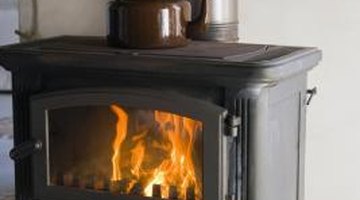Noisy Blower Motor for a Wood Stove
Wood stoves allow you to heat your home by burning wood, which you may be able to harvest locally or buy from a provider for less than the cost of heating oil or natural gas. Not all wood stoves have combustion or circulation blowers, but those that do may develop problems that cause blower motors to make noise.
Cause

A wood stove's blower can make excessive noise for a number of reasons. Some blowers are louder than others simply because their motors are more powerful. A poor electrical connection may cause a blower to stop and start, creating an intermittent noise. If a wood stove or its exhaust system leak smoke, creosote and soot particles, which are natural byproducts of wood burning, can build up on a circulation blower's blades and housing. Eventually this will cause the motor to labor and make more noise than it normally would. Finally, if the motor is experiencing a malfunction or wearing out it may become loud.
Impact
The first effect of a noisy blower motor on a wood stove is the annoyance it poses. This is especially true of a wood stove in a living room or other place where people gather. Wood stove combustion blowers force air into the stove and increase the rate of combustion. This means that a blower that makes noise as it slows down due to failure will cause the stove to burn less efficiently and produce less heat. Circulation blowers that develop byproduct buildup will also move less air and operate less efficiently.
Solutions
Each cause of a noisy wood stove blower motor has its own solution. A motor that is failing may need replacement, which is the most expensive option. New wiring may be able to save a blower that has a faulty connection. For byproduct and dust buildup, cleaning the blower blades and housing with a wire brush can restore it to its normal, quiet function. In each case be careful to avoid electrical shock by unplugging the stove when removing or installing the blower. Also, wait until the fire is out and the wood stove is cool before attempting to service or inspect the blower.
Considerations
A wood stove should be able to function without a blower. Wood stoves also vent through slits that allow air in to facilitate combustion. Once a fire is burning, it will draw in air from the room through these slits. While a combustion blower is not necessary, it does improve efficiency and create more heat, which is important if your wood stove is your sole or primary source of heat. Circulation blowers simply push warm air away from wood stoves, warming other parts of the home. When they fail, heat will simply build up in the room with the stove.
References
Photo Credits
- Jupiterimages/Goodshoot/Getty Images
More Articles



